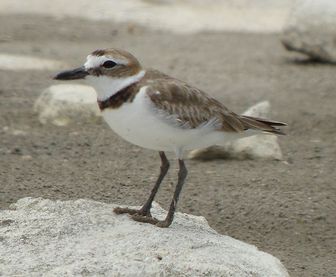Wilson's plover
Wilson's Plover is a coastal wader which breeds on both coasts of the Americas from the equator northwards. Its range extends north to include much of the US.

Original source: Own work
Author: Pascal AleixandreI, Paleixmart, the copyright holder of this work, hereby publishes it under the following licenses:Permission is granted to copy, distribute and/or modify this document under the terms of the GNU Free Documentation License, Version 1.2 or any later version published by the Free Software Foundation; with no Invariant Sections, no Front-Cover Texts, and no Back-Cover Texts. A copy of the license is included in the section entitled GNU Free Documentation License.www.gnu.org/copyleft/fdl.htmlGFDLGNU Free Documentation Licensetruetrue
Permission: GNU Free Documentation License
The Wilson's plover is classified as Least Concern. Does not qualify for a more at risk category. Widespread and abundant taxa are included in this category.
The Wilson's Plover (Charadrius wilsonia) is a small plover. Wilson's Plover is a coastal wader which breeds on both coasts of the Americas from the equator northwards. Its range extends north to include much of the U.S. eastern coast, and the west coast of Mexico in the west. It is a partial migrant. Birds leave the United States, except Florida winter south to Brazil. Some Mexican birds leave in winter to reach Peru. More
Wilson's Plover: Call is a sharp, whistled "whit." Utters grating or rasping noises in flight display or when agitated "jrrrrrid jrrrrrid." Similar Species Wilson's Plover: Heavy black bill and flesh-colored legs distinguish this species from other small plovers, including Piping Plover, Semipalmated Plover, and Snowy Plover. Killdeer has two breast bands. . More
Wilson's Plover is seldom found away from saltwater environments, where it forages for marine invertebrates, nests and roosts in small groups, occasionally alongside other smaller plover species, and defends its territory with ground and aerial chases. Sometimes called the "Thick-billed Plover," the shorebird is a swift flier that will resort to feigning injury, such as a broken wing, to distract potential predators. More
has identified the Wilson's Plover as a "species of high concern." Between 1980 and 1987, Georgia's population dropped from 360 pairs to fewer than 250 pairs. Conservation Issues & Efforts With its relatively small population and restricted breeding range, the Wilson's Plover is particularly vulnerable to habitat destruction from beachfront development, and disruption from beachgoers on their nesting grounds. The plovers abandon their nests when disturbed, leaving their eggs exposed to predation and overheating. More
Wilson's Plover: Breeds in the U.S. along the Atlantic coast from Maryland to Florida, and along the Gulf Coast from Florida to south Texas. Spends winters along both coasts of Florida and along the coast of south Texas. Resident throughout Central America and the Caribbean to northern South America. Preferred habitats include open sand or shell beaches and tidal mudflats. More
A medium-sized plover of ocean beaches, the Wilson's Plover has a single chest band and a large, thick bill. The large bill helps it catch and eat larger prey items than other plovers on the beach. More
Wilson's Plovers forage for food on beaches, usually by sight, moving slowly across the beach. They have a liking for crabs, but will also eat insects and marine worms. This bird was named after the Scottish-American ornithologist Alexander Wilson. Example alt ext References - 1. ^ Grantsau, R. & Lima, P. C. (2008). Uma nova subespécie de Charadrius wilsonia (Aves, Charadriiformes) para o Brasil. More
Wilson's Plover Spotted on Raleigh Greenway System = Adjust font-size: + – Max O' Well Published February 04, 2007 by:Max O' WellView Profile | Follow | Add to Favorites More: Fiddler Crabs Greenway Pico Marine Band Boa Poached Seagulls Plover Encroaches on Blue Heron's Feeding Ground! - Wilson's Plover spotted on Raleigh Greenway System Plover encroaches on Blue Heron's feeding ground! Wilson's Plover seems to have gone missing from its normal beachfront More
Wilson's Plovers forage for food on beaches, usually by sight, moving slowly across the beach. They have a liking for crabs, but will also eat insects and marine worms. This bird was named after the Scottish-American ornithologist Alexander Wilson. More
* Wilson's Plover is named for early ornithologist Alexander Wilson, who collected the type specimen in May 1813 at Cape May, NJ, where this species is (and was) only a rare visitor. * No known trends in populations. Listed as threatened or endangered in some states. * They will resort to feigning injury, such as a broken wing, to distract potential predators. More

Original source: Michael Rosenberg
-Michael Rosenberg -Author: Michael Rosenberg
Permission: Some rights reserved
Family : Charadriidae
Genus : Charadrius
Species : wilsonia
Authority : Ord, 1814

